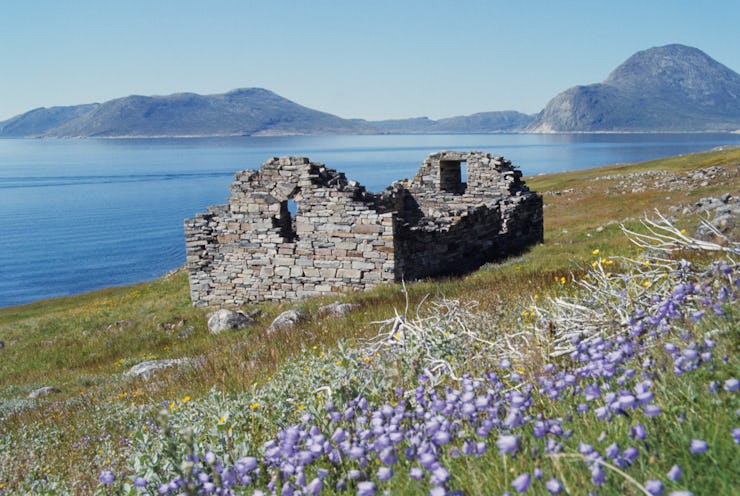Why Did the Vikings Abandon Greenland? New Study Pieces Together a Complex Answer
Sea level rise played a larger role than previously thought — but it wasn’t the only reason they left.

For over 400 years, the Vikings thrived on Greenland. Two settlements, one on the southern tip of the island and the other slightly farther up the coast, became home to a small but steady population of Norse colonists.
But by the end of the 15th century, all traces of Viking life on the island mysteriously disappeared. What’s left is one of the biggest questions in Norse history: why did the Vikings abandon Greenland?
Researchers writing today in the journal Proceeding of the National Academy of Sciences propose that sea level rise played a larger role in pushing out the Vikings than previously recognized. However, it probably wasn’t the only factor that led to their escape.
Coastal haven
The Vikings first arrived on Greenland in the year 985 CE, led by fabled Nordic explorer Erik the Red. He was exiled from Iceland after killing several people in a dispute, and made his way to nearby Greenland with a small group of people to establish a new place to live.
Their settlement was known as Eystribygð, or the Eastern Settlement. Over the next few centuries, it would become a self-sustaining community with farms and churches concentrated near the shore. Greenland’s Vikings also helped fuel the burgeoning ivory trade in Europe by hunting walruses until the beginning of the 15th century.
The final record left by Viking inhabitants on Greenland was from a wedding in the Eastern Settlement that took place around the same time. And radiocarbon dating shows that they only stuck around for about a half-century more.
The Hvalsey Church was built by Vikings at the Eastern Settlement. It was the site of the wedding that marked the final written record of Viking life on Greenland.
“The cause of the Viking abandonment of Greenland and the deteriorating conditions leading up to it remain controversial,” the authors of the new PNAS study write — noting that it was most likely a combination of factors rather than one single reason.
Previous studies on the Viking’s mysterious disappearance suggest a few ideas for their departure: clashes with Inuit communities, climate change, and disruption to trade, to name a few. But environmental shifts, especially sea level rise, are not fully understood.
For the new study, researchers modeled how the oceans changed during the time of Viking inhabitation. Notable climate events and shifting geological features around Greenland would have eventually made coastal Viking settlements nearly impossible to live in.
The Weight of a Glacier
A few centuries after the first Vikings appeared in Greenland, the Northern Hemisphere experienced a notable period of cooling. This was known as the Little Ice Age, and happened between approximately 1250 and 1900 CE.
Cooler climates led to the expansion of the Greenland Ice Sheet, which would have drastically changed the landscape. The authors explain that the larger ice sheet would have caused a phenomenon known as crustal subsidence, where the weight of glaciers would have caused nearby land to sink.
Light blue shading shows flooding along the coastline of Greenland in different areas over the time Vikings lived there. Stars mark the location of Viking settlements. The final diagram shows how close Viking sites would have been to flood zones.
Sinking coastal lands are more prone to flooding. And with the Viking’s settlements right on the edges of Greenland, ice sheet changes would have made them more susceptible to floods than areas further inland.
Using data from previous archaeological and geological studies, the researchers built a computer model to show how much sea levels changed from the start to the end of Viking inhabitation on Greenland. What they found was drastic: waters rose up to 3.3 meters during the time people lived at the Eastern Settlement.
The vast majority of known Viking sites were located within 500 to 1000 meters of a flood zone. Even if not every person living at the Eastern Settlement was personally affected by rising seas, flooding would have seemed pervasive due to its common occurrence, the authors write.
A Complicated Tale
Frequent flooding would have had a domino effect on Greenland’s resident Vikings. It would have made it more difficult to farm and raise livestock, for example — which was a major part of life at the settlements.
One previous study found that Vikings in Greenland gradually shifted their diets during the 12th century to include more sea creatures and fewer land animals. It’s possible, but not confirmed, that that could have been due to the steady loss of farmland.
With waters steadily rising over time, the Vikings probably reached a breaking point and had to leave. However, the extent that flooding pushed them out is tough to fully measure against the backdrop of many historical factors.
“It is difficult to assess the relative impact that sea-level rise had on the abandonment of the Eastern Settlement and the end of Viking habitation in Greenland in the mid-15th century compared to the other factors that have been identified in the literature,” the authors write.
But years of ubiquitous and slowly worsening floods would have been nearly impossible for the Vikings to ignore — contributing to a worsening quality of life would have made Greenland seem like a less and less appealing place to live.
This article was originally published on